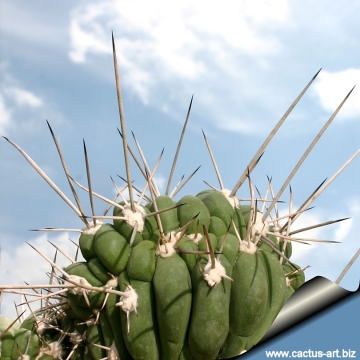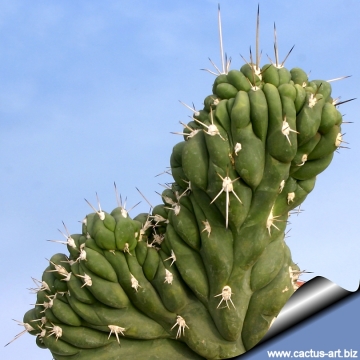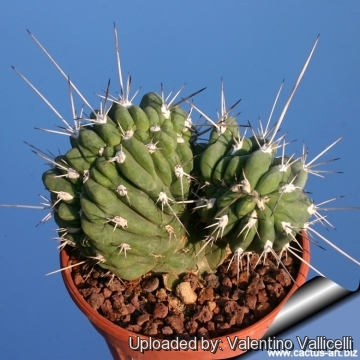
Stetsonia coryne f. cristata Photo by: Valentino Vallicelli
Origin and Habitat: Garden origin (Nursery produced cultivar) The natural plant originates from the low northwest deserts of Argentina and Bolivia
Synonyms:
See all synonyms of Stetsonia coryne
back
Accepted name in llifle Database:Stetsonia coryne f. cristata hort.Accepted name in llifle Database:Stetsonia coryne (Hort.Berol. ex Salm-Dyck) Britton & RoseCactaceae (Britton & Rose) 2: 64-65, f. 95-96, t. 9 64 1920 [9 Sep 1920]Synonymy: 3
back
Common Names include:
ENGLISH: Crested Toothpick Cactus
Description: The standard Stetsonia coryneSN|19128]]SN|19128]] is a large, tree-like columnar cactus that grows to a height of 3-10 m tall. It develops a sturdy trunk and with time can produce numerous arm-like branches. It is among the most famous cacti for the fiercely spines that cover the trunk and should prove an interesting and eye-catching plant for the specialist collector and for those wanting a somewhat different plant.
Crested form: The beautiful crested form is very rare in collection and highly priced for its sculptural shape and long spines. Older crested plant grown outdoor in the ground (in mild areas) can reach an imposing size (up to 3 m tall and in diameter, or more)
Spines: Start out creamy-white and age to black, sturdy enough to be used as toothpicks, hence the common name.
Stems: Deeply ribbed, with new growth emerging purplish blue-green and ageing to olive green.
Flowers: Large white tinted pink, night blooming that remain open 'til mid-morning.
Blooming season: Mature plants (more than 25 years old) bloom in spring or summer.
Subspecies, varieties, forms and cultivars of plants belonging to the Stetsonia coryne group
 Stetsonia coryne f. cristata Photo by: Cactus Art
Stetsonia coryne f. cristata Photo by: Cactus Art Stetsonia coryne f. cristata Photo by: Cactus Art
Stetsonia coryne f. cristata Photo by: Cactus Art Stetsonia coryne f. cristata Photo by: Cactus Art
Stetsonia coryne f. cristata Photo by: Cactus Art Stetsonia coryne f. cristata Photo by: Valentino Vallicelli
Stetsonia coryne f. cristata Photo by: Valentino VallicelliCultivation and Propagation: They are easy plant that grow large and form beautiful specimens with time.
Frost Tolerant as low as -4°C (or possibly colder) but in cultivation it is best to avoid any frost when during the winter the temperature can go down to 2° C without any harm so long as the compost is very dry. During the summer it is best to keep the plants outside where the temperature can rise to over 30 C with no harm to the plant. Furnish good drainage and use a an open and free draining mineral compost that allows therefore roots to breath. They like only a short winter's rest and should be kept almost completely dry during the winter months, If the soil is allowed to be dry for too long root loss could follow but equally the same result would occur if the plants are both wet and cold. From March onwards the plant will begin to grow and watering should be increased gradually until late May when the plant should be in full growth.
Water regularly during the summer so long as the plant pot is allowed to drain and not sit in a tray of water. During hot weather you may need to water the plants more frequently so long as the plant is actively growing. From late September watering should be reduced to force the plant to go in to a state of semi dormancy, by October you should be back in to the winter watering regime.
Need full sun avoiding only the harshest summer sun, if kept too dark they may become overly lush and greener and could be prone to rotting due to over watering.
Feeding may not be necessary at all if the compost is fresh then, feed in summer only if the plant hasn't been repotted recently. Do not feed the plants from September onwards as this can cause lush growth which can be fatal during the darker cold months. Keep well ventilated as it is prone to root rot.
Propagation: Cuttings in summer (Cuttings will root only in hot weather. Cuttings must be kept very dry to root)














